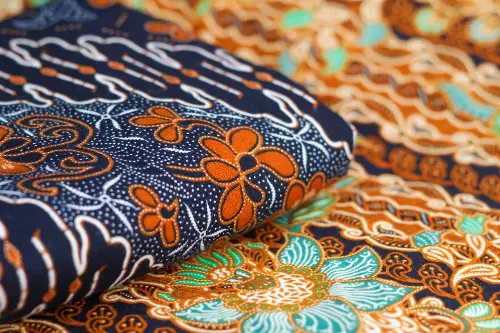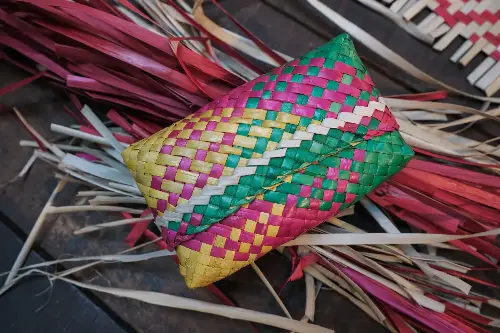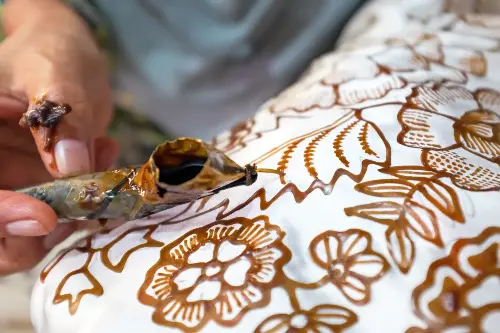Nestled in the heart of Southeast Asia, Malaysia is celebrated for its vibrant fusion of cultures, breathtaking landscapes, and delectable cuisine. Yet, beyond its rainforests and city skylines lies a world that time has beautifully preserved—the artistry of Malaysian crafts. These traditional arts, lovingly passed down through generations, offer more than just visual splendour. Each delicate batik, intricate songket, and finely woven basket tells stories of cultural pride, innovation, and the mastery of hands shaped by centuries of heritage.
The Secret Language Of Batik

Batik, with its hypnotic patterns and stunning shades, remains one of Malaysia’s most iconic crafts. Quietly practised in villages and workshops, the art of batik making is not merely about waxing and dyeing fabric; it is a silent language spoken through motifs and colours. The word “batik” itself is believed to originate from the Javanese word “tik”, meaning to dot, echoing the meticulous process behind each creation.
Malaysian batik distinctively features softer, more fluid motifs than its Indonesian cousin, often inspired by the natural surroundings—foliage, hibiscus flowers, and swooping birds. Artists use canting, a pen-like instrument, to trace hot wax onto the fabric, followed by repeated dyeing and drying, requiring both immense patience and artistic intuition. What results is a work of wearable art that not only dresses the body, but also narrates tales of everyday life and dreams. Some historians believe certain batik patterns were once exclusive to royalty or intended for special ceremonies, making each piece a unique slice of Malaysian lore.
Songket: Weaving Gold Into Tradition

If batik whispers, then songket dazzles. Known as the “queen of fabrics,” songket is a hand-woven textile glittering with threads of gold or silver. Its origins date back to the courts of the Malay Sultanates, where it was originally worn by nobility during important occasions. The hallmark of songket is the supplemental metallic threads that shimmer against a backdrop of deep, vibrant colours—a textile that balances both power and poetry.
Master weavers, often women from the east coast states like Kelantan and Terengganu, employ a centuries-old technique. Each roll of songket can take months to complete, as the insertion of metallic threads must align with precise patterns—geometric, floral, or symbolic “bunga tabur” scattered motifs meant to bestow blessings. The creation of songket is an exercise in discipline and imagination, as slight mistakes can mean starting an entire section anew. Remarkably, in an era of digital printing and fast fashion, songket’s allure has not faded. It is still a coveted piece for weddings, state events, and international runways, treasured both for its visual richness and deep-rooted meaning.
The Rattan Renaissance: Baskets, Mats, And Beyond

Beyond textiles, the art of weaving rattan and pandanus leaves stands as a testament to Malaysia’s ingenuity with local materials. Basketry, mat-making, and the sculpting of utilitarian yet decorative items are age-old traditions in many communities, especially among the Orang Asli (indigenous peoples) and in Sabah and Sarawak in Malaysian Borneo.
Artisans gather, split, and dye natural fibres using techniques that depend on perfect timing, humidity, and hand strength. These creations range from the everyday—a bubu fish trap or a dulang food platter—to sought-after collector’s pieces. The famed “tikar mengkuang” mats, crafted from screwpine leaves, are prized for their resilience and geometric beauty. Many feature patterns tied to myths and rites of passage, passed on verbally from elder to youth, ensuring continuity.
In recent years, a renewed appreciation for eco-friendly materials and sustainable living has placed rattan and pandan crafts in the spotlight. Modern Malaysian designers now collaborate with traditional weavers, blending minimalist or contemporary designs with craftsmanship that has remained unchanged for centuries.
Masters Of Craft And Keepers Of Heritage

Behind every masterpiece is a craftsperson whose life is entwined with their art. Each region is coloured by its masters—men and women who rise before dawn to coax beauty from wax, thread, or reed. Legends such as Fatimah Chik, a batik artist who merged traditional methods with modern artistry, or master songket weaver Che Tom from Terengganu, serve as living bridges between past and present.
Many of these keepers of tradition have been recognised with national awards, but for most, the real reward lies in teaching the next generation and keeping their heritage alive. The growing presence of craft workshops and open studios in places like Kuala Terengganu and Kota Bharu offer opportunities for anyone—local or visitor—to witness the slow, meditative practice of creation and perhaps try their hand at it.
Craft’s Contemporary Revival
Today, Malaysia’s artistry is undergoing a revival. Thanks to cultural festivals, online platforms, and government programmes, traditional crafts are reaching new audiences. Young Malaysians, inspired by their elders and global trends, are finding innovative ways to incorporate heritage techniques into modern fashion, home décor, and even digital art. The proud crafting heritage has become a movement, not just a memory, bridging rural traditions with urban sensibilities.
As technology advances and cultures intermingle, the soul of Malaysian craft proves resilient. Each batik sarong, songket scarf, or woven tiara is more than a product—it is a living legacy, a whisper from the past, and a promise for the future.
In a rapidly changing world, Malaysia’s timeless artistry stands as a reminder that true beauty flourishes where patience, imagination, and tradition meet—often, right in the hands of those quietly creating, stitch by stitch, pattern by pattern.
